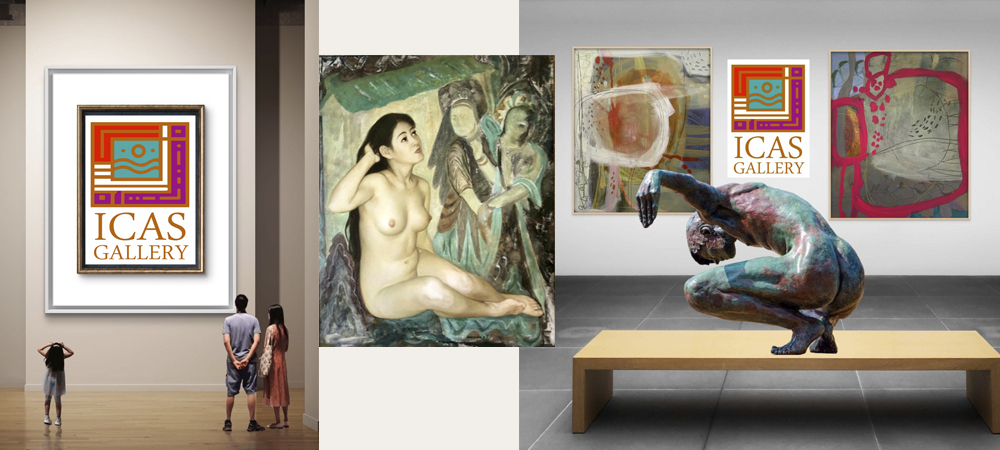

 “The Marquette on show here is a study for both of the large bronzes by John W. Mills, both of which are over nine feet high, and they are all based on my studies of Chinese Tang terracotta horses in the British Museum and other collections in France and the USA. I like the constant Reference to sculpture and sculptural solutions to observed facts embodied in the Tang horse. They are anatomically correct without being mere copies of actual beasts. In this respect, they are similar to the famous four horses of St Mark in Venice, which are Greek or Roman. It is believed that they could be the horses that pulled the Quadriga of the Delphi Charioteer. My admiration for this kind of informed sculpture prompts me to draw inspiration from it. As with the real animal, it is not a question of merely copying but making a sculpture that shows where you have been and what you have seen. I have made two versions of this subject: CHINESE DYNAMIC and CHINESE REFERENCE. Dynamic is in the Harlow collection in Essex, and Reference is in a private collection in Oxfordshire”.
“The Marquette on show here is a study for both of the large bronzes by John W. Mills, both of which are over nine feet high, and they are all based on my studies of Chinese Tang terracotta horses in the British Museum and other collections in France and the USA. I like the constant Reference to sculpture and sculptural solutions to observed facts embodied in the Tang horse. They are anatomically correct without being mere copies of actual beasts. In this respect, they are similar to the famous four horses of St Mark in Venice, which are Greek or Roman. It is believed that they could be the horses that pulled the Quadriga of the Delphi Charioteer. My admiration for this kind of informed sculpture prompts me to draw inspiration from it. As with the real animal, it is not a question of merely copying but making a sculpture that shows where you have been and what you have seen. I have made two versions of this subject: CHINESE DYNAMIC and CHINESE REFERENCE. Dynamic is in the Harlow collection in Essex, and Reference is in a private collection in Oxfordshire”.
History of Equestrian Art
Bronze, wood and terracotta were all used. ‘Around the Qin dynasty [221 to 206 BC], bronze was needed for weaponry, so they started using more terracotta.’ The types of terracotta, which include red, grey (or black), and white, can be traced to specific regions and dynasties.
The most sought-after are those from the Tang dynasty (618-907 AD). They are more critical because they have reached a high level of culture and art. Horses of the Han dynasty [206 BC to AD220] are the next most popular.’ Tang horses are rarer, he says, because they made fewer. ‘A Han emperor would have about 500 horses, while in the Tang dynasty, tombs would have as few as two.’
Tang horses are renowned for their sculptural elegance and beauty. ‘The head, trunk and legs of each horse were moulded separately, then joined before the painting of details such as the mane and trappings, which accounts for slight discrepancies in pose and surface decoration,’ Choi says.
During this period, red and brown pigments were applied over a high-fired buff pottery body, accentuating details such as knotted saddlecloths, bells, medallions, manes, and forelocks. The era is also famous for its Sancai polychrome pottery, which refers to three colours: green, yellow, and brown.
A dizzying number of classifications and categories are associated with each dynasty and geography. Poise and alertness are also admired. Choi says the standard positions include prancing, dancing (only for the emperor’s birthday), and working. ‘Open mouths fetch higher prices than closed mouths. Generally, the rarer the pose, such as a horse drinking water, the more valuable.’
 We welcome an enquiry about John W. Mills’ investment collection or for all private or corporate commissions. Book an appointment to discuss your inquiry in more detail, or call us. Direct contact Sunil Vilas,
We welcome an enquiry about John W. Mills’ investment collection or for all private or corporate commissions. Book an appointment to discuss your inquiry in more detail, or call us. Direct contact Sunil Vilas,ICAS Vilas Art Gallery
21 Commerce Way
Garden Square Shopping Centre, Letchworth Garden City SG6 3DNPhone: 01462677455
Email: info@vilasart.co.uk
ICAS Vilas Art Gallery
Garden Square Shopping Centre,
Email: info@vilasart.co.uk
ART NEWS VIDEOS & PUBLICATION
My Sculptures have allowed me to meet members of The Royal Family, which has always been an exciting and enjoyable experience.


